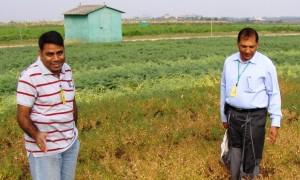“When we first started working on this project in mid-2007, our breeding programme was very weak,” says Paul Kimurto (pictured), Lead Scientist for chickpea research in the Tropical Legumes I (TLI) project, Kenya, and a lecturer in Crop Science at Egerton University.
“We have since accumulated a lot of germplasm, a chickpea reference set, and a mapping population, all of which have greatly boosted our breeding programme. From these, we have been able to select appropriate genotypes, and we obtained 400 breeding lines. None of this would have been directly possible without GCP’s support,” adds Paul. [Editor’s note: A ‘reference set’ is a sub-sample of existing germplasm collections that facilitates and enables access to existing crop diversity for desired traits, such as drought tolerance or resistance to disease or pests]
Due to their hardiness against drought, chickpeas have been steadily gaining popularity in Kenyan drylands – including the dry highlands – where they are grown as a ‘relay’ crop after wheat and maize harvests during the short rains, when the land would otherwise lie fallow. “Chickpeas have therefore increased food security and nutritional status of more than 27,000 households living in Baringo, Koibatek, Kerio Valley and Bomet Districts in Kenya, who frequently face hunger due to frequent crop failure of main staples such as maize and beans owing to climate change,” says Paul.
Chickpea adoption in these areas has increased due to close collaboration between GCP, ICRISAT and Egerton University through funding, training, resources and germplasm facilitated by GCP.
Exposure and capacity building
Through the project, various members of the Egerton research team have benefited from training in Europe, Africa and Asia on wide-ranging aspects of modern breeding, including data management. The learning resources that the team accesses through GCP are also shared widely and used as teaching materials and resources for faculty staff and postgraduate students not directly involved in the project.
“We have also benefitted from physical infrastructure such as a rain-shelter, irrigation system, laboratory equipment and a greenhouse. We didn’t have these, and probably couldn’t have had them, because all these are costly investments. This has greatly improved the efficiency of not only our research, but also our teaching,” says Paul. In addition, three postgraduate students are supported by GCP – two are pursuing PhDs and one a Masters, all using modern molecular breeding methods in their studies.
VIDEO: Paul discusses capacity building in Kenya, alongside other TLI colleagues
Community gains
Besides the university, capacity building has benefited the broader community: agricultural extension staff from the Ministry of Agriculture and from Koibatek Farmers Training Centre (one of the project’s research site), have been trained in various fields. The Centre manager attended a GCP course in Ghana tailored for research station staff (link below), as did an Egerton University technician.
In addition to aiding research trials, the irrigation system and weather station installed at Koibatek help with teaching and producing crop seed and planting materials as well as pasture for the community, since the Centre has a mandate to provide high-quality seed and livestock breeds to the community.
According to Beatrice Komen, a farmer in Koibatek, the irrigation system “has enabled the Agricultural Training Centre supply us with high-quality pasture and crop seeds for planting during the right time because Egerton University uses it to produce sufficient seed without having to rely on seasonal conditions.”
Paul adds, “The automated weather station is a first in the region.” The weather station also feeds regional data into the national meteorological database and is used for teaching by secondary schools in the community.
Going further, faster
Paul observes “With the direct funding we obtain through the project, we are able to expand into other areas of dryland research such as soil science and nitrogen fixation for chickpeas. Our efficiency has also increased: with the greenhouse and rainout shelter, we can now rapidly obtain generation crosses. And the irrigation system means we can now do off-season trials without having to wait for seasonal changes.”
“We have learnt a lot through our involvement with the Programme, including outsourcing of genotyping services which GCP fully supports, the advanced tools and wide range of services offered by the Integrated Breeding Platform for both breeding and data management,” says Paul. “We have also received digital tablet for electronic field data collection in a more efficient and accurate manner compared to the traditional pen and paper.”
The goal
“Our goal is to apply the modern breeding methods we have learnt to release new improved drought- and disease-resistant varieties before the project closes in mid-2014.” Some of these new methods include using quantitative trait loci (QTLs) through marker-assisted selection (MAS) and marker-assisted backcrossing (MABC).
“The results we obtain will provide foundation seed that can then be used for mass production through the Tropical Legumes II project,” says Paul.
“Our task is not complete until we have improved varieties in the hands of farmers,” he concludes.
VIDEO on farmer participation, and the relevance of genomics – Paul and TLI colleagues
Related links
- OPEN ACCESS BOOK CHAPTER: How to phenotype chickpeas for drought
- Chickpea research within the Legumes Research Initiative
- Chickpea facts and figures
- Join the chickpea community of practice
- SEE IT IN PICTURES! VIDEO on progress in chickpea research and VIDEO on its impacts, and the relevance of genomics to farmers










